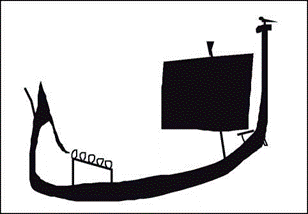First of the maritime civilizations
We complete this overview of the very first hydraulic works with a brief look at early navigation, which has prehistorical origins. The migrations that accompanied the Neolithic spread toward the western Mediterranean are thought to have been by sea. The island of Cyprus, already populated in the IXth millennium BC from Palestine or from southeast Europe, experienced the neolithic migration about 7500 BC, including the arrival of cattle from the continent. Crete was populated about 6000 BC from Anatolia.
The Sicilian Neolithic was populated through seaborne migration from the Near East, thought to have passed through Greece on the way.[28]
A fundamental invention for the development of long-distance maritime commerce appeared in the IVth millennium BC: the sailboat. The oldest evidence is a boat model found in a tomb at Eridu, one of the oldest Sumerian cities, located to the south of Ur near the Persian Gulf (Figure 1.6). This model, dating from the first half of the IVth millennium BC,[29] includes what is in effect a mast socket and attach holes for the stays. In addition, two other sailboat models that date from the IIIrd millennium and are similar to the one found at Eridu, have been recovered at the mouth of the Indus.
 |
 |
Important maritime routes (Figure 1.3) provided very early links among the Euphrates, the region of Bahrain (Dilmun of the Sumerians), the Oman peninsula[30] [31] (Magan) and the Indus (likely the region called Meluhha). The Indus civilization founded a kind of trading base facing the Persian Gulf, at Suktagen Dor, as well as a port to the east, at Lothal. On this site there is a large rectangular basin made of clay bricks, and whose purpose is still subject to debate: freshwater reservoir, or basin of a port?
From the IIIrd millennium BC, Egypt also developed maritime routes, through the Red Sea to the legendary land of Punt (to the east of Sudan), and between the Nile and
the Phoenician ports of Byblos, and Sidon. The first evidence of a sailboat in Egypt, found on a vase (Figure 1.6), dates from about 3100 BC;[32] large seagoing sailing vessels appear in Egyptian engravings from 2400 BC.[33]
The first European civilization may be that of the Cyclades, in the Aegean Sea, in the Bronze Age during which commerce in metals plays an important economic role. Images of boats with tapered ends have been found on the island of Syros, engraved on objects of unknown usage, called “frying pans” by archaeologists, dating from about 2400 BC (Figure 1.8). These boats have many oars but appear to have neither mast nor sail; they are curiously similar to the boats with oars painted on Egyptian vases at the end of the IVth millennium BC. At the beginning of the IInd millennium BC, the Cretan navy operated shuttles connecting sites of the Aegean Sea, Syria (the port of Ugarit), Cyprus, Byblos, and Egypt. Cretan engravings and seals generally show boats with many oars, and a single mast carrying a sail. Starting in 1400 BC, the Greek navy, along with its Phoenician counterpart, protected and enabled long-distance commerce in the Mediterranean.
|
Figure 1.8. Image of a tapered boat with numerous oars, after one of the objects called “frying pans” found at Syros, in the Cylades (about 2400 BC). Note the similarity with the boat of Figure 1.7, in particular the bow figurehead, here in the form of a fish (Sketch after Casson, 1971). |
Construction of hydraulic works thus was clearly driven by the need for irrigation and flood protection. But it was also driven by the need to maintain fluvial communication links, and to develop new maritime connections between the basins of the various major rivers. We will see several examples of this in later chapters, including on the Nile itself, between the Nile and the Red Sea, along the middle course of the Euphrates, between the Tigris and the Euphrates, and between the Yellow River and the Yangtze River – the famous Grand Canal.







Leave a reply